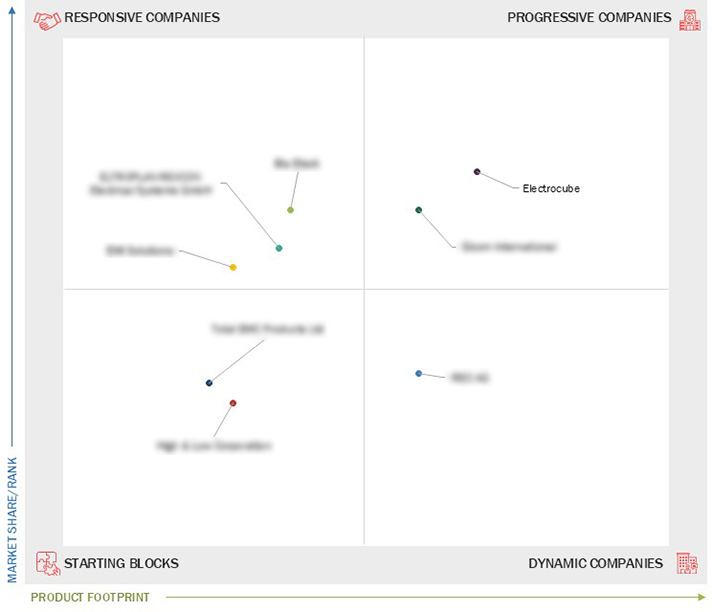Comparing 8 vendors in EMC Filtration Startups across 0 criteria.
EMC (Electromagnetic Compatibility) filters are electrical components designed to suppress high-frequency electromagnetic noise produced by various electrical and electronic systems, including electric motors, control units, power supplies, microprocessors, and inverters. For these devices to function reliably within electromagnetic environments, they must not generate electromagnetic interference (EMI) that disrupts the performance of other nearby equipment.
Market Leadership Quadrant
1.1 Study Objectives
1.2 Market Definition
1.3 Study Scope
1.3.1 Markets Covered and Regional Scope
1.3.2 Inclusions and Exclusions
1.3.3 Years Considered
1.4 Currency Considered
1.5 Unit Considered
1.6 Limitations
1.7 Stakeholders
2.1 Introduction
2.2 Market Dynamics
2.2.1 Drivers
2.2.1.1 Rising IoT adoption and smart infrastructure development
2.2.1.2 Increasing implementation of stringent regulations to reduce EMI
2.2.1.3 Mounting demand for automated machinery and industrial robots
2.2.1.4 Expansion of data centers in developing countries
2.2.1.5 Burgeoning demand for power electronics
2.2.1.6 Shifting preference from fuel-based to electric vehicles
2.2.2 Restraints
2.2.2.1 High manufacturing costs
2.2.2.2 AvAIlability of alternative technologies
2.2.3 Opportunities
2.2.3.1 Mounting demand for miniaturized electronic devices
2.2.3.2 Rising government initiatives to promote renewable energy
2.2.3.3 Increasing deployment of 5G networks
2.2.4 Challenges
2.2.4.1 Adherence to stringent regulations with rapid technological innovation
2.2.4.2 Ineffectiveness in high-switching-speed applications
2.3 Trends/Disruptions Impacting Customer Business
2.4 Value Chain Analysis
2.5 Ecosystem Analysis
2.6 Investment and Funding Scenario
2.7 Technology Analysis
2.7.1 Key Technologies
2.7.2 Complementary Technologies
2.7.3 Adjacent Technologies
2.8 Patent Analysis
2.9 Trade Analysis
2.10 Porter’s Five Forces Analysis
2.10.1 Threat of New Entrants
2.10.2 Threat of Substitutes
2.10.3 Bargaining Power of Suppliers
2.10.4 Bargaining Power of Buyers
2.10.5 Intensity of Competitive Rivalry
3.1 Introduction
3.2 Key Player Strategies/Right to Win
3.3 Revenue Analysis
3.4 Market Share Analysis
3.5 Company Valuation and Financial Metrics
3.6 Brand/Product Comparison
3.7 Company Evaluation Matrix: Startups/SMEs
3.7.1 Progressive Companies
3.7.2 Responsive Companies
3.7.3 Dynamic Companies
3.7.4 Starting Blocks
3.7.5 Competitive Benchmarking: Startups/SMEs
3.7.5.1 Detailed list of key startups/SMEs
3.7.5.2 Competitive benchmarking of key startups/SMEs
3.8 Competitive Scenario
3.8.1 Product Launches
3.8.2 Deals
4.1 Electrocube
4.1.1 Business overview
4.1.2 Products/Solutions/Services offered
4.1.3 Recent developments
4.2 Elcom International
4.2.1 Business overview
4.2.2 Products/Solutions/Services offered
4.2.3 Recent developments
4.3 Bla Etech
4.3.1 Business overview
4.3.2 Products/Solutions/Services offered
4.3.3 Recent developments
4.4 ELTROPLAN-REVCON Electrical Systems GmbH
4.4.1 Business overview
4.4.2 Products/Solutions/Services offered
4.4.3 Recent developments
4.5 EMI Solutions
4.5.1 Business overview
4.5.2 Products/Solutions/Services offered
4.5.3 Recent developments
4.6 REO AG
4.6.1 Business overview
4.6.2 Products/Solutions/Services offered
4.6.3 Recent developments
4.7 Total EMC Products Ltd
4.7.1 Business overview
4.7.2 Products/Solutions/Services offered
4.7.3 Recent developments
4.8 High & Low Corporation
4.8.1 Business overview
4.8.2 Products/Solutions/Services offered
4.8.3 Recent developments


 IT News Online
IT News Online
 Nov 2023
Nov 2023

